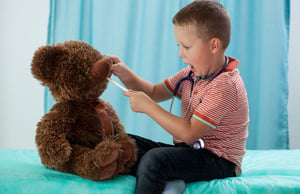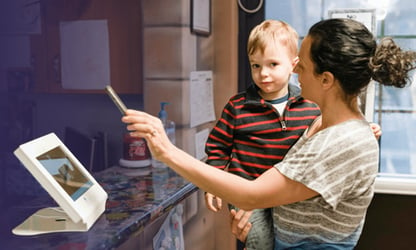 The importance of mitigating the spread of illness in your preschool has never been more acute. With the unrelenting COVID-19 pandemic hovering over the world, parents are on high-alert. When they drop their children off at your preschool, the responsibility falls on your shoulders to maintain standards that minimize the chances of spreading any illness, including the novel coronavirus.
The importance of mitigating the spread of illness in your preschool has never been more acute. With the unrelenting COVID-19 pandemic hovering over the world, parents are on high-alert. When they drop their children off at your preschool, the responsibility falls on your shoulders to maintain standards that minimize the chances of spreading any illness, including the novel coronavirus.
Considering that you will likely receive questions about your protocol and disinfecting methods, now is the time to perfect your preschool’s efforts in preventing the spread of illness. Here are some ways to do so.
Establish a Daycare Sick Child Policy
A daycare sick child policy establishes guidelines for parents and guardians to follow should their child display illness symptoms. Additionally, a sick policy outlines your procedure should a child arrive with or develop symptoms while they are under your care. To be mindful of COVID, you may also want to perform daily temperature checks as children arrive. Here are some key considerations to help you determine how to create a sick policy for your daycare.
Understand When to Send Children Home
At what point do you send a sick child home? These are symptoms to be aware of and respond to by having the child picked up to prevent illness's further spread.
- Fever. If a child presents with a temperature of 100.4 degrees Fahrenheit or higher, the child has a fever. The child should stay home until they have been fever-free for twenty-four hours.
- Vomiting or diarrhea. If a child displays either of these symptoms, sending them home is the right decision. As with fevers, the child should remain home until they have been symptom-free for at least 24 hours.
- Coughing. What constitutes a “cough”? Well, if a child is coughing continuously over a period, they should be sent home.
- Pink eye. If a child has red, puffy eyes that are watery and might have yellow-toned discharge, they could have pink eye. Considering the easy spread of the illness, they should be sent home.
- Sore throat. If a child has a sore, red throat that you notice or they bring to your attention, they should be sent home.
- Chills or sweating. Absent hot weather, if a child is sweating profusely or has chills, they should be sent home.
- Rash. If a child has a rash, they should be sent home. Rashes can be contagious.
- Runny nose. A runny nose with discharge that is yellow to green in color is a symptom of illness. The child should be sent home.
- Itchy scalp. If a child is itching their head an abnormal amount or complains of itchiness on the scalp, they should be sent home and checked for head lice.
Sanitizing Classroom Materials
Children in preschool often share and play with the same toys and materials. Sanitizing these items is of the utmost importance to maintain a high standard of cleanliness and minimize illness spread in your preschool. Through sanitizing, you kill 99.9% of germs that live on surfaces.
In addition to toys, sanitize dishes, diaper changing areas and bathrooms, including any surfaces that have or had body fluids on it. Tables, chairs, door handles and windows deserve special attention. As you sanitize, keep the following in mind.
- Wear disposable gloves before you begin your cleaning process.
- Dirty surfaces should be cleaned with soap ahead of disinfection.
- Use an EPA-registered household disinfectant, closely reading and following the instructions on the label.
- Porous surfaces, such as carpeted floors, drapes, rugs and curtains should be laundered if possible. Otherwise, they should be disinfected with EPA-approved products made for porous surfaces.
- Frequently touched surfaces such as sinks, doorknobs, light switches, desks and tables should be disinfected consistently throughout the day.
- Throughout the day, collect toys as they become dirty. Separate them in containers: one for stuffed and cloth toys, and another for plastic and wood toys. This makes it easier to clean them with the correct product once you begin the sanitation process. Soft toys often can be washed in a washing machine, though check the label each time to be certain. Wood or plastic toys can be washed in a dishwasher, though this may vary. Reading the label is recommended.
Setting Parameters for Safe Return
For singular symptoms, as described in the child sick policy section, a 24-hour symptom-free period should hold before allowing the child to return. However, with the novel coronavirus, there is a cluster of symptoms to be aware of: fever, cough, runny nose, vomiting and diarrhea.
A child can return to preschool if it has been at least fourteen days since the date of their positive coronavirus test, and at least twenty-four hours of no symptoms. For an illness other than coronavirus, twenty-four hours of no symptoms is a safe time frame.
Preventative Measures for Preschool Illness Management
Aside from sanitation and cleanliness in your preschool, there are preventative measures you can take that will ease the strain of managing illness. Here are some ways to stay a few steps ahead of potential issues.
Make Sure Each Child Has Multiple Emergency Contacts
Parents and guardians can be busy at work, or may not be able to respond as quickly as needed in an emergency circumstance. Given the heightened alertness that the pandemic has cast over society, having multiple emergency contacts reduces the odds that you cannot find someone to take care of a sick child, or to take them to a hospital if needed. Request more emergency contacts by reaching out to parents and guardians via email, phone, or in-person when they come to pick up or drop off their child.
Send Out Yearly Flu-Shot Notices
Flu season comes around each year, which is why communicating flu-shot information to parents is a good practice to cultivate. Pass along information that leaves no question: where to get them, who offers them for free, and statistics related to the deadliness of the flu.
Emphasize Regular Hand-washing
Regular hand-washing is an important practice that preschoolers should get in the habit of doing. Make it a part of your daily routine by having children wash their hands upon entering the building, before eating, after eating, during bathroom breaks and at the end of the day.
Maintain Contact with Families
If a child has a contagious illness, such as pink eye, strep throat, a viral bug, or something similar, have parents contact you about it. This allows your daycare to give other parents a heads up and ensure they keep an eye out for symptoms in their children. Contact needs to be established both ways.
Managing Health Conditions in Daycare
Some students may have preexisting health conditions that will have to be managed throughout the year. The most common conditions include allergies, diabetes and asthma.
Allergies
Allergies affect about 8% of children in the U.S., meaning that about 1 in 13 children will struggle with them. This high occurrence rate means you will likely encounter preschoolers with allergies. Children with food allergies require close monitoring of their food intake and a safe environment for them to learn and play. Familiarize yourself with allergy emergencies and the right steps to take. Having everything on hand will make it easier to handle an allergic reaction.
Diabetes
Diabetic preschoolers require closer supervision to maintain their treatment regimen and to keep them safe. They might need help taking medication, checking blood sugar levels and require specific dietary provisions. Close contact with parents and the child’s doctor is essential.
Asthma
Asthma is often triggered by environmental pollutants, such as tobacco smoke or dust mites. A preschooler with asthma may have specific triggers, of which you should be aware. Thus, a close relationship with the child’s caretakers and doctor will allow for cooperation in managing the child’s asthma.
Key Takeaways
Managing illness is challenging, but with the right policies and procedures in place, your daycare will be primed to care for sick children and keep other students safe. Generally, sick children should be sent home to recover, so keeping open communication lines is crucial to your sick child policy's success. Keeping children safe in child care takes time and effort. However, once you have a strong procedure in place, families, staff and students will have peace of mind.








.jpg?width=450&height=250&name=34-K-12-School-Templates_thumbnail%20(1).jpg)



